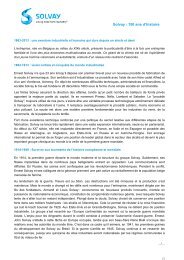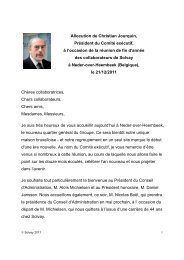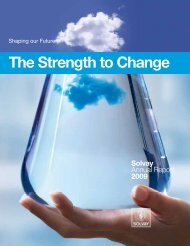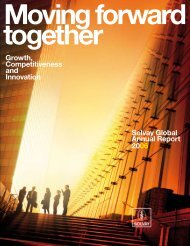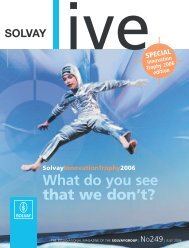Pharmaceuticals Sector - Solvay
Pharmaceuticals Sector - Solvay
Pharmaceuticals Sector - Solvay
Create successful ePaper yourself
Turn your PDF publications into a flip-book with our unique Google optimized e-Paper software.
88<br />
<strong>Solvay</strong> Global Annual Report 2005<br />
(31) Derivative fi nancial instruments<br />
The <strong>Solvay</strong> group uses derivatives to cover clearly identifi ed foreign exchange and interest rate risks (hedging<br />
instruments). However, the required criteria to apply hedge accounting according to IFRS are not met in all cases.<br />
This means that this form of accounting is not always applicable when the Group covers its economic risks.<br />
Managing the transactional exchange risk<br />
This is the exchange risk which attaches to a specifi c transaction, such as Group company buying or selling in a<br />
currency other than its functional currency.<br />
a) Hedging transactional exchange risk when certain<br />
Subsidiaries are required to transfer their foreign exchange positions (e.g. customer invoices, supplier invoices) when<br />
certain, to the CICC (1) coordination center. This systematic hedging centralizes the Group’s foreign exchange position<br />
at CICC and relieves operating subsidiaries of the administrative burden of exchange risk management.<br />
CICC’s foreign exchange position is then managed under rules and specifi c limits which have been set by the Group.<br />
The main management tools are the spot and forward purchase and sale of currencies, and the purchase of options.<br />
b) Hedging forecast short / medium-term foreign currency fl ows<br />
Forecasted foreign currency fl ows are regularly mapped, by SBU, in order to measure the Group’s expected<br />
exposure to transactional exchange risk on an annual horizon.<br />
In its present structure, the Group’s exposure is essentially linked to the EUR / USD risk: the Group is «long» in USD<br />
by around USD 600 million a year (this fi gure has increased since the Fournier acquisition), i.e. the Group’s overall<br />
activities generate a net positive USD fl ow.<br />
Based on this mapping and depending on market conditions, foreign exchange hedging can be carried out on the<br />
basis of budgeted fl ows. The main fi nancial instruments utilized are forward currency sales and the purchase of put<br />
options.<br />
From the accounting point of view, where applicable this hedging is documented in such a way that it can be<br />
processed as a «perfect hedge».<br />
During 2005, based on cash fl ow forecasts, the <strong>Solvay</strong> group hedged USD 574 million of EUR / USD exchange risk<br />
(EUR 188 million relating to 2005 and EUR 386 million relating to 2006).<br />
The effects of this hedging are allocated by SBU and accounted for, depending on the accounting classifi cation,<br />
either as sales or as other fi nancial gains and losses.<br />
Managing the exchange risk on debt<br />
Group borrowings are generally carried out by the Group’s fi nancial companies, which make the proceeds of these<br />
borrowings available to the operating entities.<br />
The choice of borrowing currency depends essentially on the opportunities offered by the various markets.<br />
This means that the selected currency is not necessarily that of the country in which the funds will be invested.<br />
Nonetheless, operating entities are fi nanced in their own local currencies, with this currency being obtained, where<br />
appropriate, by currency swaps against the currency held by the fi nancing company. The cost of these currency<br />
swaps is included under the cost of borrowing. These enable us to limit the exchange risk both in the fi nancial<br />
company and in the company fi nally using the funds.<br />
In emerging countries it is not always possible to borrow in local currency, either because local fi nancial markets<br />
are too narrow and funds are not available, or because the fi nancial conditions are too onerous. In such a situation<br />
the Group has to borrow in a strong currency. Nonetheless the Group has taken advantage of any opportunities to<br />
refi nance its borrowing in emerging countries with local currency debt.<br />
(1) <strong>Solvay</strong> Coordination Internationale des Crédits Commerciaux, S.A.


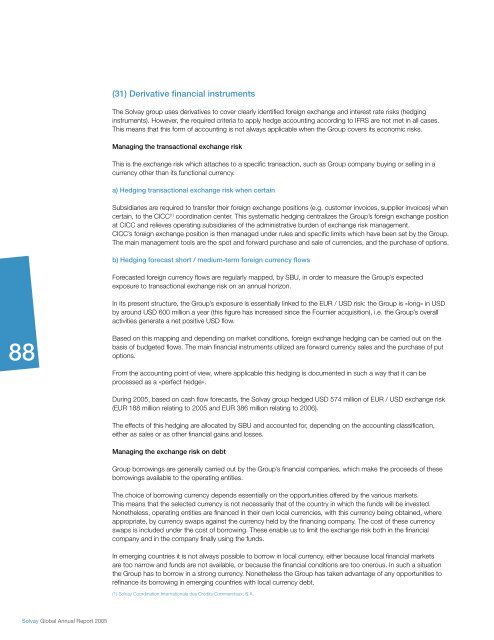

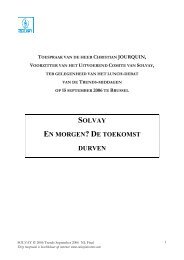
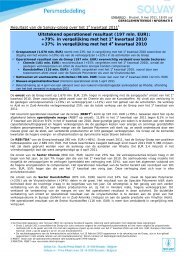

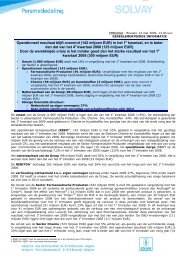
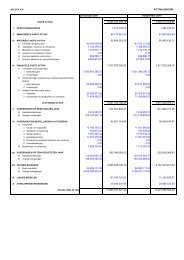

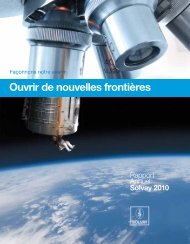
![PROC.1 [LETTRE] - Solvay](https://img.yumpu.com/16585746/1/184x260/proc1-lettre-solvay.jpg?quality=85)
